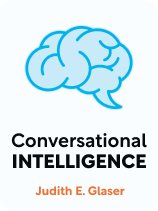

This article is an excerpt from the Shortform book guide to "Conversational Intelligence" by Judith E. Glaser. Shortform has the world's best summaries and analyses of books you should be reading.
Like this article? Sign up for a free trial here.
Do you feel disconnected from your employees? How do you build trust in the workplace?
If you want to build trust in the workplace, you need to follow Judith Glaser’s advice in her book Conversational Intelligence. She says that you first need to identify your conversational blind spots, then take control of the conversation yourself.
For more details on how to build trust in the workplace, keep reading.
1. Identify Your Blind Spots
The first step in learning how to build trust in the workplace is to identify your blind spots. As a leader, you must be aware of and work to resolve your conversational blind spots that prevent the other person from trusting you, writes Glaser. Conversational blind spots are cognitive blocks in the way we see the world and perceive others, which can negatively affect how we interact with them.
(Shortform note: While you’re working on conversational blind spots, it might be helpful to also examine if you have other, general blind spots that affect your ability to lead. Such blind spots can be fear of asking others for help and not respecting the time and needs of employees, among other things. You can combat these by soliciting honest feedback from peers.)
Here are four conversational blind spots:
Blind Spot 1: We tend to believe others feel and think the same way we do. If we aren’t open to the possibility that others think differently, then when others disagree with us about an issue, we’ll try to convince them we’re right. This leads to the other person feeling bullied or strong-armed and prevents them from trusting us.
(Shortform note: Glaser mentions these four conversational blind spots but doesn’t always indicate how to avoid them. To combat Blind Spot 1, you might develop empathy, which Brené Brown defines as the capacity to understand what someone else is feeling and to feel that, too. Empathy will allow you to appreciate that others have different opinions and feelings than yours.)
Blind Spot 2: We aren’t aware that fear and distrust affect how we react to situations. As we mentioned above, distrust makes you create and reinforce incorrect mental narratives about others. You might thus react to them based on your mental narrative and not based on what they’re actually saying and doing. What’s more, distrust and fear keep you from taking others’ perspectives because you’re on the defensive. You become unable to put yourself into another’s shoes, which makes it hard for them to trust you.
(Shortform note: To know when you’re afraid or distrustful and when those feelings might be impacting your actions, tune in to your body to detect the physical symptoms of fear. These might be an increased heart rate, fast or shallow breathing, sweating, or trembling. If you’re feeling any of these, it may be a sign that you’re afraid and that you’re seeing your conversation partner in a negative light. Consider taking a break from the conversation to allow your fear response to cool.)
Blind Spot 3: We’re not aware that our memories of a conversation are subjective. The way we recall a conversation might not be what truly happened, and if we act only based on this subjective reading of a situation, the other person feels they can’t trust us to be open-minded and accepting.
(Shortform note: It’s true that memories are subjective and don’t necessarily reflect what really happened. This is because, when your brain creates a memory, it fills in gaps in that memory—moments or bits of conversation you didn’t store in your mind—with fabricated, assumed information. For instance, if you didn’t store how your co-worker greeted you this morning, you may fabricate a memory in which they greeted you in a rude way. If you assume that’s an objective truth and not a fabrication of your brain, you’ll likely be rude to them in return, reinforcing a cycle of distrust.)
Blind Spot 4: The listener may misinterpret what the speaker said. Meaning can be lost or misinterpreted between speaker and listener, so both parties must check in at the conclusion of an interaction to ensure they’re on the same page.
(Shortform note: One way to check in at the conclusion of an interaction—or to fix a misinterpretation—is to use what the authors of Crucial Conversations term contrasting. This is expressing your intention in an “I do/I don’t” statement, as in: “I do need the document by the end of the week. I don’t need it to be perfect.”)
2. Control the Context of a Conversation to Maximize Trust
To encourage trust from the start of a conversation, control the context in which you hold it, says Glaser. She refers to this as priming the other person—and yourself—to be trusting and open. You can prime both individuals and groups for more trusting conversations.
One-on-One Meetings
For individuals, Glaser suggests you create a context in which you can be warm and receptive to the other person by holding a warm beverage or sitting in a comfortable chair in advance of a meeting. Warmth and comfort signals your brain to be more receptive and open.
You can also control the context of the conversation by changing the physical setup of the space so that it doesn’t signal that you’re at the top of a hierarchy. For instance, you might sit side-by-side on a couch with your employee, rather than across from them at a desk, which gives the physical impression of authority over the other person.
Glaser’s final recommendation for a one-on-one meeting is to always first shake hands with the other person. This makes your brain release oxytocin, which lets you feel connected to the other person.
Group Meetings
To encourage trust among groups, begin meetings with a trust-building exercise, writes Glaser. She proposes an exercise in which you ask everyone to suggest rules that will lead to the best conversation and write those down on a whiteboard. When you do such exercises, you signal to the amygdala (the fear center of the brain) that there’s no danger.
You can also foster trust at a meeting by sending out the agenda ahead of time so participants can propose amendments. Once you’ve received the amendments, send a revised agenda. This helps people to feel that their opinions and needs are valued, which makes them more trusting.
(Shortform note: Building trust is particularly important and challenging in virtual meetings, in which members may have never met in person and so have not had the chance to establish trust and connection. You can foster trust by clearly framing the purpose of the meeting so everyone knows what type of participation is expected of them. Sending out an agenda or questions ahead of time, as Glaser proposes, is also a good strategy to encourage people to open up in a virtual meeting. Finally, ask your opening questions in the chat, which lets people participate in the conversation with little pressure.)
3. Ask Open-Ended Questions
Another way to establish trust is to ask open-ended questions which make the responder feel valued and willing to speak openly, writes Glaser. Closed questions are ones that can be answered with just a “yes” or “no,” or that are really statements disguised as questions, to which the asker is expecting a specific response (“The company should move in this direction, don’t you agree?”). Open-ended questions, in contrast, don’t beg a specific response and can lead to discovery and learning (rather than confirmation of what you already think). They also help you understand the perspectives of others, allowing you to lead more effectively.
For instance, open-ended questions might be: “How do you feel about this direction for the company? What fears and hope do you have around it? Do you see yourself thriving here in the future?” Such questions encourage the other person to think about their response and to feel they can freely share their thoughts—which increases their trust in you.
(Shortform note: Asking open-ended questions is an essential part of coaching employees, a process Michael Bungay Stanier describes in The Coaching Habit. This suggests that by learning conversational intelligence, you’ll also become a better coach. Stanier describes seven specific open-ended questions you can ask in general meetings with employees to become a better coach. For example, “What do you want?” or, “How can I support you?” These questions encourage trust and understanding in a conversation, no matter what the context.)

———End of Preview———
Like what you just read? Read the rest of the world's best book summary and analysis of Judith E. Glaser's "Conversational Intelligence" at Shortform.
Here's what you'll find in our full Conversational Intelligence summary:
- The importance of conversations to human growth and success
- How to deploy conversational intelligence and avoid dialogue-killing distrust
- The five steps to regain trust if you've lost it






